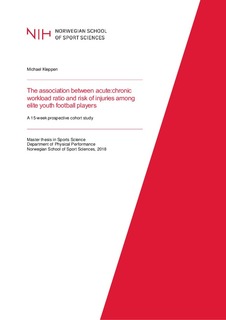| dc.description.abstract | A high injury rate has been reported in elite youth football. Injuries can have detrimental consequences for the youth elite athlete, not only interrupting their personal and team chances of success, but also as a potential burden later in life. An important part of reducing risk of injury in football is understanding the risk factors that may predispose the athletes to an injury. Training load (TL) has received increased attention as an important modifiable risk factor for injury in football and a growing level of research has investigated the training load-injury relationship using the acute:chronic workload ratio (ACWR) in adult elite football. However, research in youth elite football is scarce and the purpose of this master thesis was to investigate TL as a risk factor for injury, using the ACWR-method.
A cohort of male and female elite youth football players (n=86) were followed prospectively for a study period of 15 weeks. A self-reporting surveillance method, using a text message-based system was used to collect information on daily training load and injury. TL for all football related activity (match and training) was registered using the session-RPE (sRPE) and injury was registered according to an all complaints definition. For the ACWR analysis, TL-data was categorised based on z-scores and “traditional”-values. The ACWR was analysed as one-week acute load divided by four last week chronic (1:4 week) rolling averages and “Exponentially weighted moving averages” (EWMA) method for both of the TL categories.
An incidence rate of 15.9 injuries per 1000 hours of exposure was found when using an all complaints definition. Alternatively, when classifying injuries according to time loss definition, incidence rate was 4.7 injuries per 1000 hours of exposure. An increased risk of injury was found for players with a high ACWR compared to medium and a low ACWR. A low ACWR did not have a different risk compared to medium ACWR. | nb_NO |
